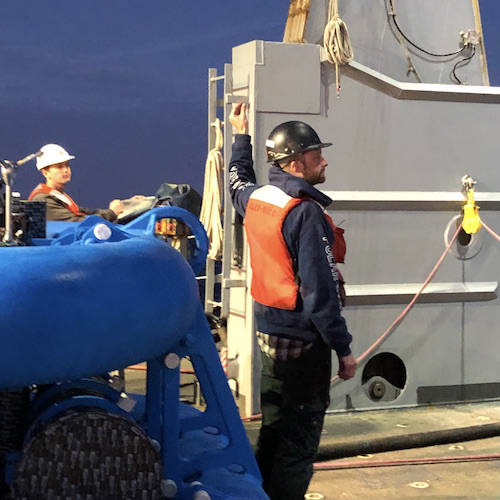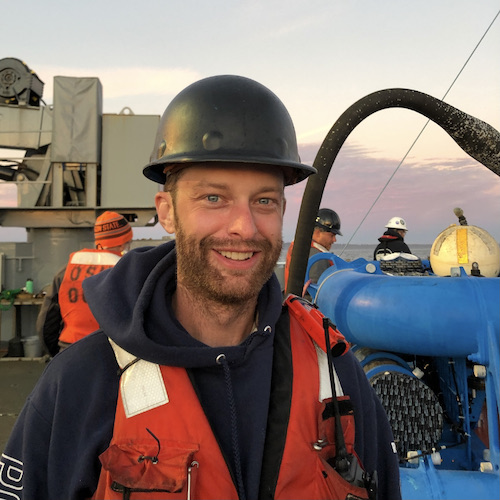Alex Wick: Conducting Sea-going Operations
OOI Coastal Endurance Array Deck Lead Alex Wick has been working on ships for more than a decade. He is a classic example of learning the ropes from the bottom up. After receiving a degree in marine biology from the University of Santa Cruz, he took some scuba diving lessons, but really didn’t know what he wanted to do.
Wick started his journey aboard ships in 2012 sorting tools for a marine technician onboard the R/V Point Sur, out of Moss Landing, California. When offered the job, he had no idea what he was getting into. He showed up in shorts, street shoes, with no personal protective gear (PPE) at all, and no at-sea experience.
But he learned quickly and advanced from sorting sockets to needle-gunning the deck, which involves removing all of the old paint with a needle gun before applying a new coat of paint. This activity was when Wick was given his first set of PPE – safety glasses, knee pads, hard hat, and gloves – which gave him a real understanding of their importance during five days of back-breaking work.
Wick started repainting the deck of the boat. The captain, at the time, recognized Wick’s work ethic and dedication and continued to expose him to shipboard duties. From one cruise as a deck hand, he advanced to an 84-day expedition to Antarctica. He jokes that at the time he didn’t even know how to use a ratchet strap, which is widely used to secure heavy equipment on ships and elsewhere.
“The captain told me to secure a small boat under the A-frame,” said Wick. “I had no idea how to do, but figured it out. With one day of oceanographic experience under my belt, I was off to Antarctica.” As it turned out, it was the best possible hands-on learning experience for Wick, which ultimately led to him spending about 500 days at sea and his role with the Endurance Array team today.
“There was nothing like driving a boat in Antarctica with a guy with a crossbow on the bow of the boat directing me around chasing Minke whales,” added Wick. “We would come up alongside one of them, shoot a crossbow bolt into its dorsal fin to retrieve a bio-sample. I thought it was the coolest thing ever.”
This Antarctica expedition provided Wick with the foundational knowledge he now uses aboard the R/V Thomas G. Thompson during bi-annual recovery and deployment expeditions for the Coastal Endurance Array. His time on the Point Sur taught him how to run winches, use the A and J frames, which support the lifting of heavy equipment in and out of the ocean, and most importantly, how to work on a ship in a safe manner.
After Antarctica, Wick spent six years as a deck hand and marine technician, where he developed an innate understanding of how all the pieces move on deck. Jonathan Fram, who often serves as chief scientist for the Endurance expeditions likens Wick to a symphony conductor. “He directs the operations while always having an eye on each member of the ‘orchestra’ and what they should be doing at certain times. This orchestration is critical to getting the heavy equipment we deal with on and off board without incident.”
Wick moved to Oregon State University when his wife was accepted into a PhD program there. He was hired on as a marine technician on the R/V Oceanus, where he sailed for up to 100 days a year. But, a man of many interests, Wick grew tired of being away from home for such long stretches. He missed his family, mountain bike, fishing, and other activities afforded by living in Oregon. He applied for the job as deck lead with the Endurance Array team and has been on the job since December 2018.
His first trip to the dock in Newport after a fall Endurance expedition, where he saw the massive amount of equipment moved on and off the ship and in and out of the water, provided Wick with his leadership philosophy.
“I think that the person running the deck should be basically completely hands off. That way, we are able to actually observe everything and see the bigger picture of what’s happening,” said Wick. “As we’re doing recoveries or deployments, I’m always thinking of the next pieces of the puzzle. I want the folks on the back deck and on the bridge to know what to expect, so everyone knows what’s ahead and can plan for what they’re going to be doing.”
From the seeds of his earliest experience aboard the R/V Point Sur, Wick is totally committed to overseeing a safe operation. “The deck lead is responsible for everyone’s safety and making sure we’re doing things appropriately,” he explained. “Sure unexpected things can happen, but back deck operations can and should be done safely. I feel a great responsibility for making sure that everybody comes back with all their digits and we all return to shore having successfully completed the job and return to our family and friends.”
Wick’s favorite part of the job is working with the team. He joked, “We are all part of the communal suffering. Doing the same thing together. We have a lot of big toys that we get to play with safely. And, it really is special at sea. It’s cool to see the whales breaching, the dolphins racing the ship, the bioluminescence, and skies filled with stars. No matter how crusty and jaded we might be, it takes a team to put these moorings in the water, and deep down, I think we all really enjoy doing this.”
Wick has served as deck lead for six Endurance expeditions and has overseen the movement, deployment and recovery of 270 tons of scientific equipment. Not a bad record for a kid who started out sorting tools.


